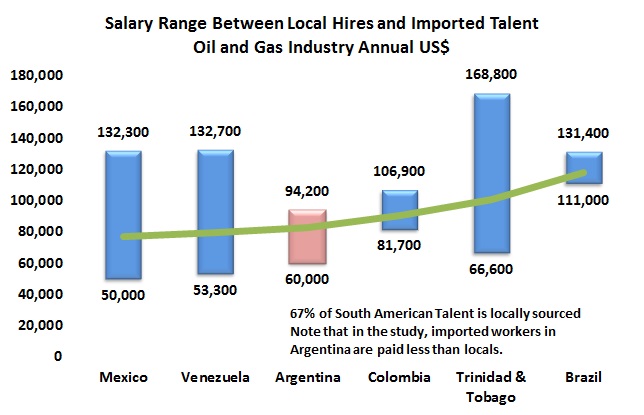We have heard Orlando Cabrales give the speech so many times while he was president of the National Hydrocarbons Agency (ANH) that we could probably deliver the slides ourselves, perhaps even in our sleep. Now German Arce Zapata has taken over. He avoided the CWC Colombia Oil and Gas Summit and Exhibition in Cartagena, leaving that job to MinMinas Renjifo and went to Punta del Este in Uruguay to deliver, if not his maiden speech then one of this first presentations. We are just not sure we like the message. From an ANH press release, translated and with comments by Hydrocarbons Colombia

The annual Hays “Oil and Gas Global Salary Guide” is always an interesting read, filled with information. This chart shows the average salary for a local worker in the oil and gas industry, the average salary for an imported i.e expat worker and the estimated average (the heavy line). There are lots of questions about sample size and methodology (why, for example, are imported workers to Argentina paid less than locals?) but the data is interesting none-the-less.
Minister of Mines and Energy Federico Renjifo spoke to an important legal conference in Cartagena this week. This was not his speech to the CWC Colombia Oil & Gas Summit and Exhibition which our correspondent said was the same speech trotted out at every conference and so unworthy of commentary. These remarks to senior lawyers and judges reflect the fine line that the Santos government is trying to tread between developing extractive industries while maintaining high environmental and community relationship standards. From a MinMinas press release, translated and with commentary by Hydrocarbons Colombia.
We will report separately on MinMinas Renjifo’s comments to the annual CWC Colombia Oil & Gas Summit and Exhibition in Cartagena but there was a lively forum on exploration that got to the heart of the country’s current problems with reserve growth. The issue for the industry participants in a round table and especially for Talisman’s Chris Spaulding and Gran Tierra’s Duncan Nightingale is that Colombia is not drilling anywhere close to enough wells.
A delegation from the port of the La Coruña visited Colombia to establish business relationships with large oil companies in the country and “implement at Punta Langosteira a new bulk liquid terminal that would be added to the Repsol and Pemex terminals.” According to a statement by the port, during the visit, the delegation met with executives of Ecopetrol, who “very explicitly showed interest in the potential of the outer port as a hub , specifically for its excellent location to host a processing and mixing terminal for crudes from Latin America and light crudes from northern Europe.”
National newsmagazine Dinero reports on its ‘rumors’ page that President Juan Manuel Santos is about to do a cabinet shuffle. The last such shuffle in September brought Federico Renjifo from MinInterior to MinMinas. Dinero reports that Renjifo is one of those rumored to be leaving at least his current post in the shuffle.
National weekly news magazine Semana published an article that analyzes whether the FARC may have surface to air missiles to shoot down aircrafts. Recent statements by U.S. General John Kelly put the issue on the table. In a speech before the U.S. Senate Armed Services Committee, Kelly said that the FARC have surface-to-air missiles acquired with their income from the cocaine trafficking.
Ecopetrol has been pushing its good corporate citizenship with a series of press releases on its spending in 2012. Environmental investments, local purchasing and local hiring have all been touched. While this may seem like ‘tooting its own horn’, we believe such a campaign is necessary for the industry as a whole, because of the negative opinions held by the press and certain politicians. From an Ecopetrol press release, translated and with comments by Hydrocarbons Colombia.
Business magazine Dinero reported that lawyer Camilo Araque filed a demand at the Constitutional Court against article 101 of Law 1450 of 2011. Araque considers that this article, which decrees that the Ministry of Mines and Energy is in charge of setting the price of fuel, “displays an incontrovertible ignorance of the Constitution.”
As reported by national radio station W Radio, Alberto Mariño, manager of Coviandes, the company developing the Bogotá-Villavicencio four-lane road, referred to the project designs and required investment. According to Mariño, some US$550M for the land purchase, labor, materials and insurance policies will be allocated. He said the projected was “largely” on time according to the project plan.